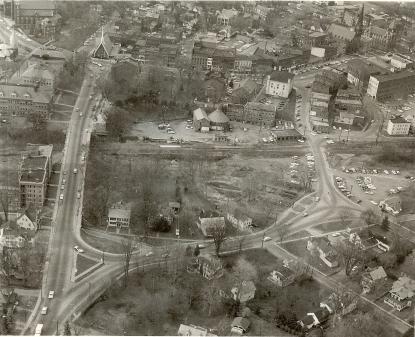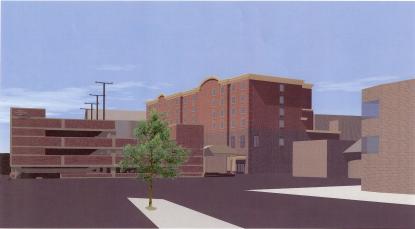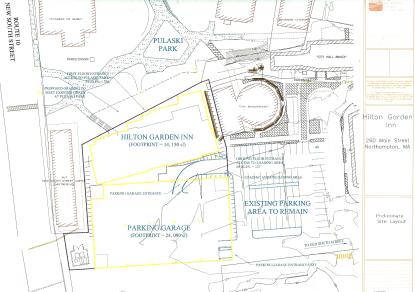
undated photo Round House and proximity circa 1960
(see more in gallery to the left)
I attended the recent Round House parking lot environmental cleanup update meeting held at 5:30 PM Monday April 23, 2007 at the MacDonald House at 49 Old South Street in Northampton.
Of the 20 or so residents in attendance, 4-5 expressed concerns that this was the first time a public meeting was being held for them, 2/3 of the way through the clean-up. Bay State Gas (BSG) official Robert Cleary politely disputed this, indicating there had been meetings held in the City Hall annex that drew 30 people and at Forbes Library which drew zero attendees, prior to commencing the clean up. Several residents indicated outreach to them at MacDonald House had been poor and it’s notable that there were no elected officials present for the meeting. A sparsely attended meeting was held earlier in the day according to an attendee of both meetings. A resident pointed out that there was environmental remediation occurring during the paving of the MacDonald House parking lot the year before, without notice. Mr. Cleary assured residents that at no time was anyone placed in danger and that any dust that did circulate in the air, then or now, would not contaminate residents’ window gardens. He added that by design, remediation employees currently working on the site are not wearing respirators and are utilizing only safety goggles, hard hats, and steel-toed boots.
air quality meters on Pulaski Park fence
Mr. Cleary provided an interesting history of the use of coal tar and the former plant. Beginning in 1856 (the same year the Northampton State Hospital opened) coal was carried to the site via railroad and was ‘roasted’ to create gas, which was then distributed to illuminate city streets, homes, and industry. Coal tar was stored in ‘holders’ similar to the existing Round House, which is currently used as an office building. There were two main holders in the Round House parking lot and one located where the MacDonald House parking lot is today. The brick and mortar holders were unlined and ran to depths of twenty feet underground. It was improperly assumed that the coal tar stored in them would create an inner seal but unfortunately tar and oil leaked out creating a significant underground plume that stretches from New South Street to Pleasant Street and is bordered by Main Street and the former Mill River channel and Maplewood Shops (see picture below). Mr. Cleary indicated that the plume’s depth ranges from 7 feet to 15 feet to 25 feet underground, and poses no significant health risks to people or Northampton water supplies. He indicated any future site work on the former Mill River bed would occur several feet above the plume. He indicated that the coal-works plant operated until about 1950, when a natural gas pipeline was installed along with Interstate 91.
In 1973 Bay State Gas acquired the former Northampton Gas Works site and donated what is now utilized as the City Hall annex to the city for use as a municipal building.
In 2001 test borings discovered the presence of a coal tar residue known as ‘coke'(sp?) that is a commercial by-product used in steel making. Coal tar was also used on city streets, to make creosote which is used to coat the base of utility poles, and to seal roof tops, driveways, and the like. Coal tar contains many hazardous compounds that are today regulated by the Department of Environmental Protection and the Environmental Protection Agency. Mr. Cleary pointed out that many of the same compounds can be found in the exhaust of our cars and furnaces.
Several residents again expressed concerns regarding what they feel has been a failed public relations process regarding resident buy-in of the site’s clean up. One asked why Mayor Mary Clare Higgins, State Representative Peter Kocot, and State Senator Stan Rosenberg were not present to answer questions and asserted that work should be halted immediately in order for MacDonald House residents to participate. Concern was expressed that the clean up is not considered a ‘public’ process, therefore notification standards of abutters is not stringent. Residents stated tensions within MacDonald House were heightened as residents are divided on whether the clean up constitutes sound public policy or not.
digging the coal tar and dirt
coal tar and dirt
Mr. Cleary reiterated that the site clean up posed ‘no significant health risk’ to anyone and that the top three feet of earth is to be removed and replaced with clean fill, paying extra attention to areas surrounding underground utilities that might be disturbed in the future. Mr. Cleary stated they are removing 5,000 tons of material, or 3,500 cubic yards. He added that Bay State Gas is going beyond what the law requires with regards to reaching out to the community, but promised to intensify future efforts in that regard. He said their work should be completed by early June.
Attendees pointed out that many MacDonald House residents have vision and mobility impairments that make attending meetings off-site difficult. Mr. Cleary responded that there has been no calculated plan to exclude residents, and that BSG had spoken to ‘city people’ and municipal employees regarding the site work. He said that DEP representatives visit the site several times per week and that residents can visit the site with the city’s licensed site professional or contact Peter LaGoy, NiSource Environmental Health and Safety Consultant. Mr. LaGoy can be reached at plagoy@nisource.com or 508-836-7073.
Representing the city was Planning Director Wayne Feiden who suggested the city started thinking about redeveloping the site in the 1970s. During his tenure in the Planning Department the city held its first public meeting in 1999 and started applying for and receiving grants in 2000 and 2001 to assess the site and test for hazards. He said two of the grants paid for the city to hire Licensed Site Professional Kevin O’Reilly and attorney Lou Moore.
Mr. Feiden stated the Army Corps of Engineers committed in 2002 to revitalizing the nearby portion of the Mill River but that federal funding has been diverted for ongoing mitigation efforts resulting from the September 11, 2001 World Trade Center bombings. He doesn’t anticipate work on the Mill River restoration to commence any time soon. He reiterated the city’s commitment to infill development in order to preserve trees in the outlying areas of Northampton. Mr. Feiden indicated there were 15 parties interested in the site, but only two bidders. (See my archived February 23, 2007 "Round House request for proposals" entry for more commentary on that process.) He concluded with an announcement that there would be a public meeting held May 15 regarding the design of the hotel and parking garage and that there would also be a meeting held May 23 or 24 regarding the site plan for the project.

garage and hotel to rise above coal tar
tucking-in the coal tar beneath an orange membrane
spreading gravel
meters are checked
more gravel

the new scheme
site remediation plan
underground toxic plume
former structures circa 1930


